
Proceedings of the EuSpRIG 2019 Conference “Spreadsheet Risk Management” ISBN : 978-1-905404-56-8
Copyright © 2019, EuSpRIG European Spreadsheet Risks Interest Group (www.eusprig.org) & the Author(s)
Page 1/12
Implementation Strategies for Multidimensional
Spreadsheets
Paul Mireault
Founder, SSMI International
Honorary Professor, HEC Montréal
Paul.Mireault@SSMI.International
ABSTRACT
Seasoned Excel developers were invited to participate in a challenge to implement a spreadsheet with
multi-dimensional variables. We analyzed their spreadsheet to see the different implement strategies
employed. We identified two strategies: most participants used a projection of three or four-
dimensional variables on the two-dimensional plane used by Excel. A few participants used a
database approach where the multi-dimensional variables are presented in the form of a dataset table
with the appropriate primary key. This approach leads to simpler formulas.
1 Introduction
Expert guidelines for developing spreadsheets, such as (Raffensperger, 2003) and (FAST Standard
Organisation, 2016), recommend shorter formulas with fewer references.
Researchers have studied the complexity of spreadsheets because of its impact on the risk of having
errors. (Bregar, 2004) developed a complexity metric that takes numerous factors into account, such
as the number of operators and operands, the nesting, and the dispersion of references. Combining
approaches from Software Engineering and Linguistics, (Reschenhofer, Waltl, & Matthes, 2016) have
also developed a metric based the analysis of a spreadsheet’s formulas. Using the concept of smell in
Software Engineering, (Hermans, Pinzger, & van Deursen, 2014)measured complexity with the
number of operators and of references, the length of calculation chains and the presence of duplicated
formulas.
What all those research projects and expert recommendations fail to do is take into account the
complexity of the problem itself, and that cannot be done with only an analysis of the formulas in a
spreadsheet file.
Even though a spreadsheet has two dimensions, rows and columns, one of the spreadsheet's
dimension is usually used to represent variables. This leaves the other spreadsheet’s dimension to
represent one of the model’s dimension, such as time. But real-world problems can be more complex.
For example, we may want to model unit sales by month, by region and by product, thus needing a
three-dimensional variable. The challenge's problem had variables in up to four dimensions: month,
sector, product and region.
In this paper, we will describe how some Excel users implement a multidimensional structure. The
structure is the one described in (Mireault, 2018).
We recruited the participants in the study through an Internet challenge. The challenge kit consisted of
the problem description and its solution, presented in the form of a Formula Diagram and a Formula
List. The kit also contained an Excel file with the data and the desired Interface sheet and it also
contained two screen captures showing the desired results given two different inputs. The participants
could then validate themselves to make sure that their calculations were correct.
This research is an explorative study to see what techniques Excel developers use to implement
multidimensional variables. Since participation was voluntary, we cannot do any statistical inference
with the results.
Proceedings of the EuSpRIG 2019 Conference “Spreadsheet Risk Management” ISBN : 978-1-905404-56-8
Copyright © 2019, EuSpRIG European Spreadsheet Risks Interest Group (www.eusprig.org) & the Author(s)
Page 2/12
2 Recruiting the participants
An invitation to participate in the challenge was sent to the EuSpRIG mailing list(EuSpRIG, 2019)
and on the LinkedIn Excel Developers group(LinkedIn, 2019), with encouragements to redistribute
the invitation in other circles. The challenge lasted one month from November 1 to November 31,
2018. The participants had to request the kit by email, which allowed us to measure the interest level.
There were 109 kit requests and 17 of them submitted a spreadsheet. We did not investigate why
potential participants did not complete the challenge, but some did communicate that they were too
busy or that they found the problem too complicated and did not know how to implement it.
The participants were given a problem along with its solution: all the variables and the formulas were
presented in the Formula List. Their task was not to solve the problem, but to implement its given
solution. The participants were free to use any feature that did not require non-standard features: it
had to work in a simple Excel installation.
The Formula List contains 5 variables with more than two dimensions.
MSP Unit Sales
and
MSP
Sales Amount
are in the (Month, Sector, Product) dimension set,
MSPR Unit Sales
and
MSPR
Variable Cost
are in the (Month, Sector, Product, Region) dimension set, and
MPR Unit Sales
is in
the (Month, Product, Region) dimension set. Those are the variables that interested us in this analysis.
3 Initial analysis
Given the voluntary lack of directives, some participants did not implement all the variables of the
Formula List. They avoided implementing some multidimensional variables by building more
complex formulas. For example, the two four-dimensional variables,
MSPR Unit Sales
and
MSPR
Variable Cost
can be avoided by changing the given formulas for the variables that depend on them:
MPR Unit Sales
,
Monthly Unit Sales
and
Monthly Variable Cost
. So, the formulas
MPR Unit Sales = SUM( MSPR Unit Sales )
and
MSPR Unit Sales = MSP Unit Sales * Region Sales Distribution per Sector
were combined by some participants to calculate
MPR Unit Sales = SUM( MSP Unit Sales * Region Sales Distribution per Sector ).
This was unfortunate for this study, as we were interested in seeing how the variable
MSPR Unit
Sales
was implemented in their worksheet. But since the four-dimensional variables were not
presented as output variables in the Interface sheet their implementation was mathematically correct.
4 Implementation strategies
The implementation strategies used by the participants can be assigned to two broad categories that
we'll call the Database approach (DB) and the Variables and Formulas approach (VF). The VF
approach is well used in one or two-dimensional spreadsheets in business and finance applications.
In a one-dimensional spreadsheet, the variables, like Unit Sales, Cost and Revenues, are usually
represented in rows, with columns on the left-side documenting them with their name and, sometimes,
their units. One dimension, like Month or Region, is presented in a row at the top and columns
represent the instances of the dimension, such as Jan, Feb, Mar or South, North. The formulas appear
in a rectangular shaped area below the dimension row and to the right of the variables. Normally, the
formulas linking the variables are written for one instance of the dimension and then copied under the
other instances to the right.
Implementing two dimensions starts to be a bit more involved. One method consists of presenting the
second dimension along with the first one. All the instances of the first dimension are then repeated
for each instance of the second dimension. Thus, if we have twelve months and three regions, the set
of twelve months (Jan, Feb… Dec) will be repeated for each of the three regions, giving 36 columns.
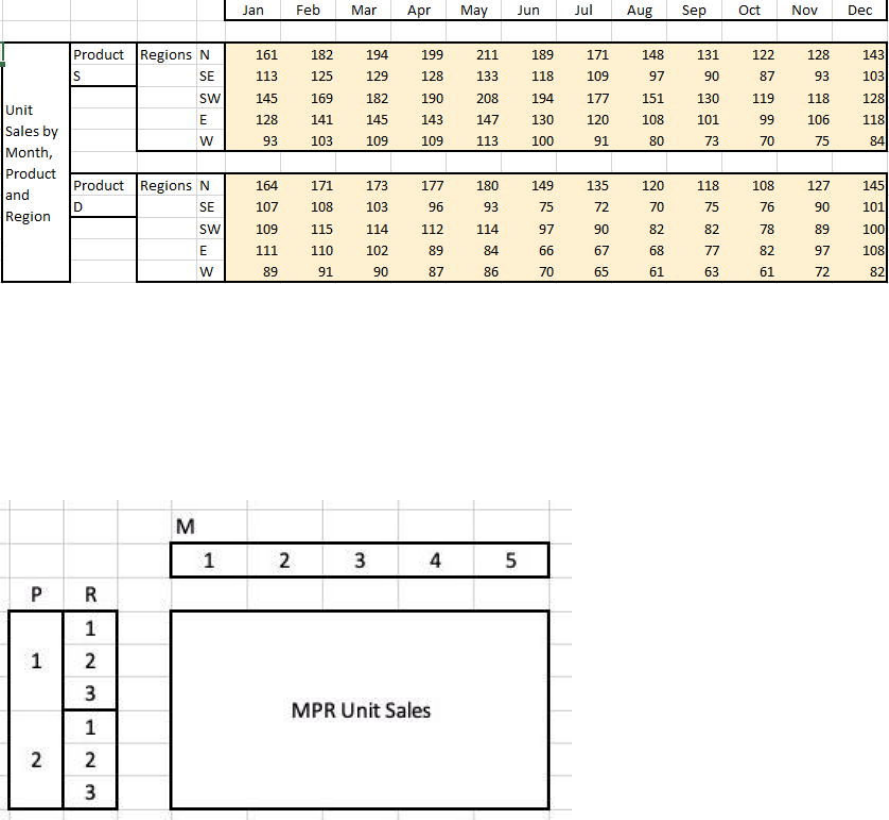
Proceedings of the EuSpRIG 2019 Conference “Spreadsheet Risk Management” ISBN : 978-1-905404-56-8
Copyright © 2019, EuSpRIG European Spreadsheet Risks Interest Group (www.eusprig.org) & the Author(s)
Page 3/12
Another method consists of subsuming a dimension with variables. Thus, instead of having one
variable
Sales
with 36 instances—
Sales(North, Jan)
, to
Sales(East, Dec)
— we create three
variables named
Sales North
,
Sales South
and
Sales East
. And there remains only one
dimension, Month, with 12 instances. Usually, calculations with variables with the same suffix are
grouped together. Thus the calculations of Sales North, Cost North and Profit North would appear in
the same area and then would be reproduced and adjusted for Sales East, Cost East and Profit East.
4.1 Three-dimensional variables
We had two 3-dimensional variables,
MSP Unit Sales
and
MSP Sales Amount
in the (Month, Sector,
Product) dimension set, and
MPR Unit Sales
is in the (Month, Product, Region) dimension set. This
variable was also shown as an output variable in the Interface sheet given to the participants, as shown
in Figure 1.
Figure 1MPR Unit Sales in the Interface sheet
Not surprisingly, all but one participant adopted that representation in their calculation sheet. Since
participants had different ways of showing a particular structure (with different formats, spacing,
etc.), we will represent this structure with a diagram as shown in Figure 2.The diagram shows that the
Month dimension is in columns and the Product and Region dimensions are in row. Furthermore, the
Products are in sequence and the Regions are repeated for each instance of the Products. The body of
the structure is the calculation of the MPR Unit Sales variable.
Figure 2 Diagram of Structure MPR1
One participant chose to calculate the variable with a different structure. In this case, all the
dimensions were represented in rows, as shown in Figure 3. Our representation of that structure is
shown in Figure 4.
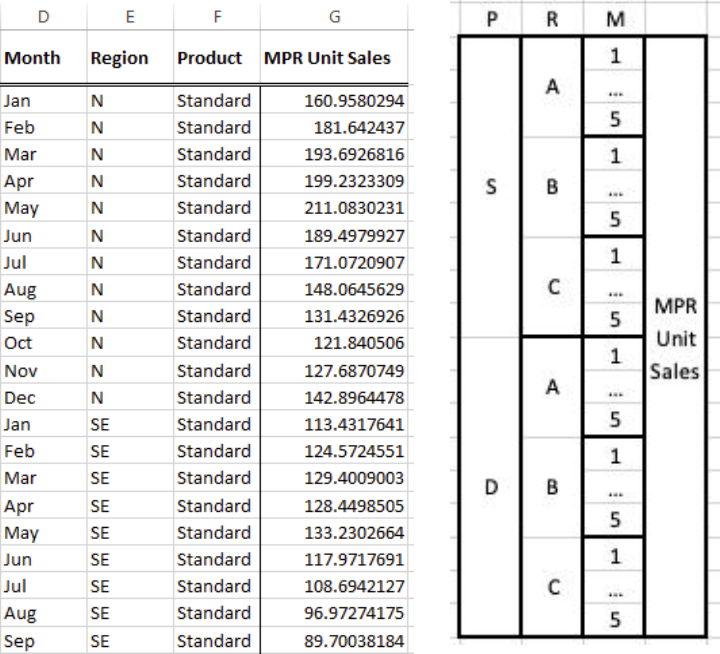
Proceedings of the EuSpRIG 2019 Conference “Spreadsheet Risk Management” ISBN : 978-1-905404-56-8
Copyright © 2019, EuSpRIG European Spreadsheet Risks Interest Group (www.eusprig.org) & the Author(s)
Page 4/12
Figure 3 Alternative MPR Unit Sales Calculation
Figure 4 Alternative Structure MPR2
With the MSP structure, the participants had no suggested representation and they had a variety of
structures. We identified six different structures, shown in the following figures.

Proceedings of the EuSpRIG 2019 Conference “Spreadsheet Risk Management” ISBN : 978-1-905404-56-8
Copyright © 2019, EuSpRIG European Spreadsheet Risks Interest Group (www.eusprig.org) & the Author(s)
Page 5/12
Figure 5 Structure MSP1
Figure 6 Structure MSP2
Figure 7 Structure MSP3
Figure 8 Structure MSP4
Figure 9 Structure MSP5
Figure 10 Structure MSP6
Structures MSP1 and MSP3 are similar, and so are MSP2 and MSP4. We can also note the similarity
of structures MPR2 and MSP6: they both perform all the calculations in a single column.
4.2 Four-dimensional variables
Seven participants avoided calculating the two four-dimensional variables,
MSPR Unit Sales
and
MSPR Variable Cost
. The 10 other participants had 6 different structures, shown in the following
figures. StructuresMSPR1 and MSPR4 were each used by 3 participants, all the others were used by a
single participant.
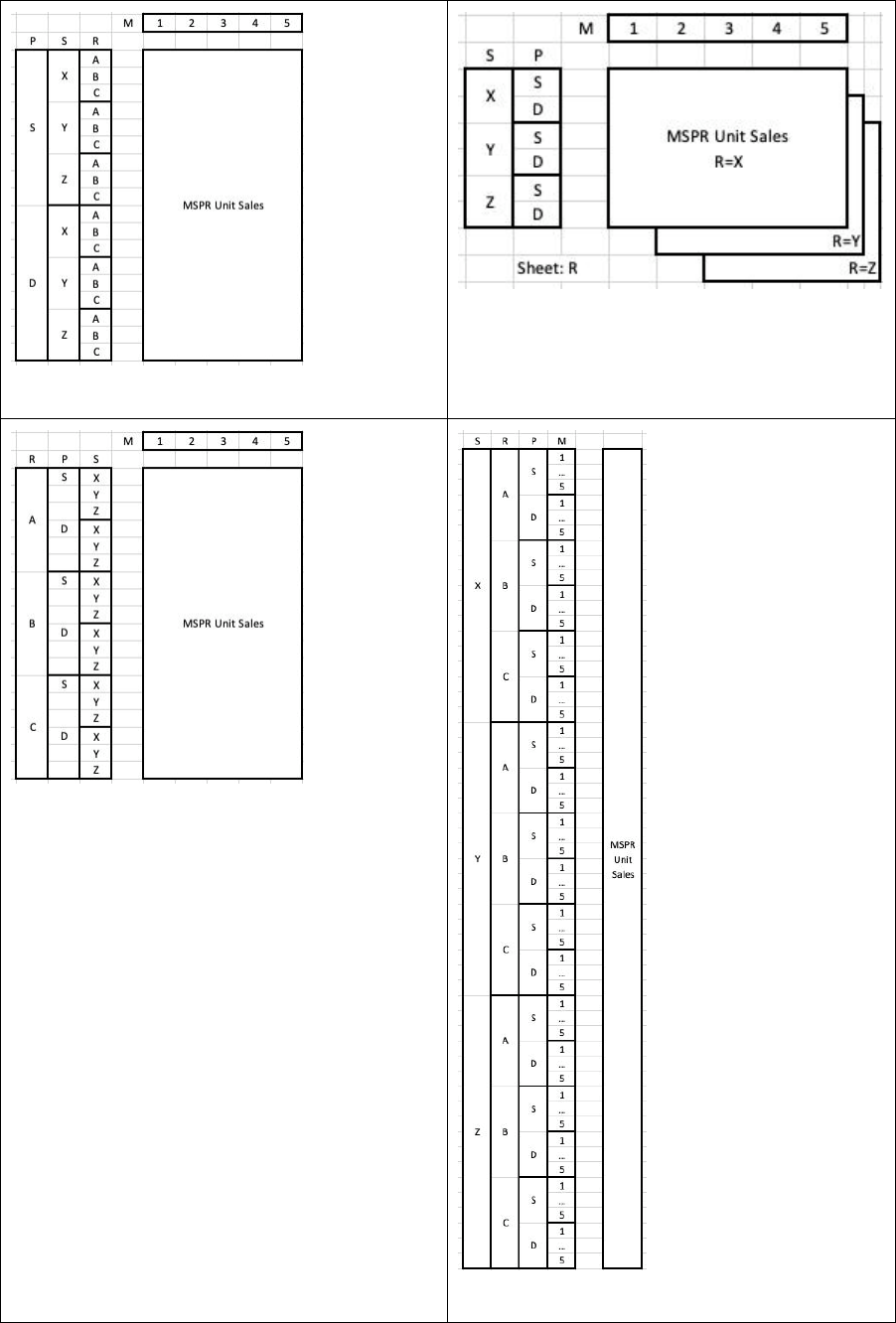
Proceedings of the EuSpRIG 2019 Conference “Spreadsheet Risk Management” ISBN : 978-1-905404-56-8
Copyright © 2019, EuSpRIG European Spreadsheet Risks Interest Group (www.eusprig.org) & the Author(s)
Page 6/12
Figure 11 Structure MSPR1
Figure 12 Structure MSPR2
Figure 13 Structure MSPR3
Figure 14 Structure MSPR4
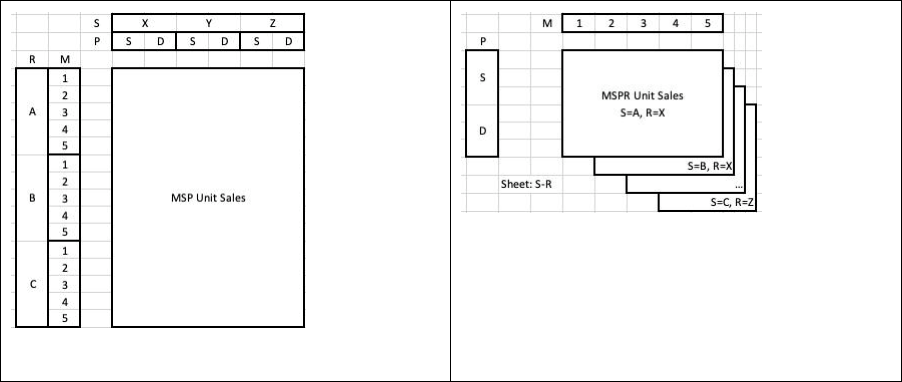
Proceedings of the EuSpRIG 2019 Conference “Spreadsheet Risk Management” ISBN : 978-1-905404-56-8
Copyright © 2019, EuSpRIG European Spreadsheet Risks Interest Group (www.eusprig.org) & the Author(s)
Page 7/12
Figure 15 Structure MSPR5
Figure 16 Structure MSPR6
4.3 Database approach
Some participants used a strategy we call the Database approach. This approach consist of using
structure MSPR4 and calculating all the problem variables in each row of the table. The columns M,
S, R and P collectively form the primary key of the table and, separately, serve as foreign keys to
form relations with the other dimension sets. The resulting table was then used with Excel database
tools like Power Query, Pivot Tables or SUMIF functions to calculate all the aggregate variables
required in the Interface sheet.
Using Power Pivot and Pivot Tables requires a manual recalculation after changing the
Base Price
input variable, and can be inconvenient for users who want to do scenario analysis with Excel’s What-
If Tables.
5 Discussion
As noted above, some participants avoided creating 3 or 4 dimensional variables that were not
required in the Interface sheet, even though they were in the supplied Formula List. As a result, their
formulas tended to be much more complex than those using the multi-dimensional variables. For
example, the formula to calculate the
MPR Unit Sales
using
MSPR Unit Sales
is described in the
Formula List as:
MPR Unit Sales = SUM(MSPR Unit Sales)
It is implemented as
=SUM(J51:J54)
and
=SUMIFS(tblProcess[MSPR Unit Sales], tblProcess[Product
Name],$E$4,tblProcess[Region Name],$G3,tblProcess[Month Name],H$1)
and
=SUMIFS(Sales[UnitSales],Sales[Region],$F3,Sales[Month],G$1,Sales[TypeAbbrev],$D$4)
by participants who used a MSPR structure,
and as
=SUMPRODUCT((G$31:G$34)*($W$31:$W$34)*($Y$31:$AC$34)*($Y$30:$AC$30=$F3))
and
{=SUMPRODUCT(Data!$F$29:$F$32*Data!$B$11:$B$14*TRANSPOSE(Data!$J5:$M5)*TRANSPOSE(OF
FSET(Data!$J$14:$M$14,COLUMNS($G$1:G$1),)))}
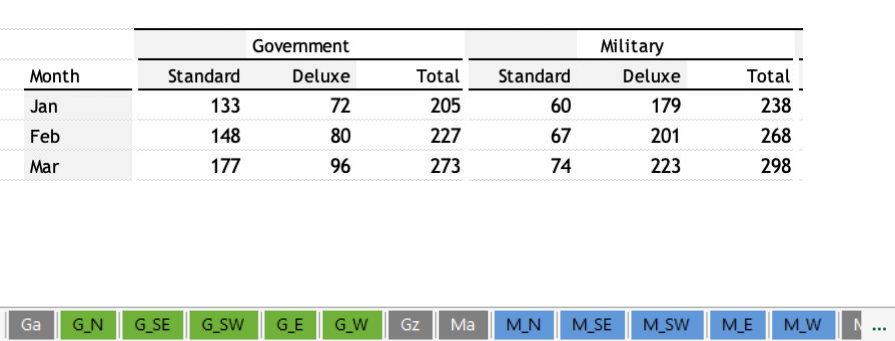
Proceedings of the EuSpRIG 2019 Conference “Spreadsheet Risk Management” ISBN : 978-1-905404-56-8
Copyright © 2019, EuSpRIG European Spreadsheet Risks Interest Group (www.eusprig.org) & the Author(s)
Page 8/12
and
=SUMPRODUCT(OFFSET(Data!$J$5,MATCH($F3,Data!$I$5:$I$9,0)-
1,0,1,4),OFFSET(Data!$T$15,MATCH(G$1,Data!$I$15:$I$26,0)-1,0,1,4))
by participants who did not use a MSPR structure.
Some participants also mixed variables of different dimension sets in the same calculation areas. This
is often done to calculate aggregate values and presents a visually pleasing table view, as shown in
Figure 17 where the body of the table calculates variable
MSP Unit Sales
and the column labelled
Total calculates
MS Unit Sales
. This organization makes it hard to copy formulas from left to right,
and is a potential error risk during future maintenance.
Figure 17 Mixing variables of different dimension sets
Two participants used worksheets to represent one or two dimensions. One used bookends sheets to
simplify the use of the SUM function (see Figure 18and structure MSPR6).
Figure 18 Modeling dimensions with sheets
The formula to calculate MPR Unit Sales is simply
=SUM(Ga:Gz!G3)
. The bookend sheets (Ga, Gz,
Ma, Mz, etc.) are empty, and one would only need to add a sheet between them to have it used in the
SUM. Thus, adding a Sector-Region sheet in the proper place would not require any change in the
aggregate formulas.
Participants using the Database approach usually have the simplest formulas for aggregated variables.
We expect that they will be the easiest to maintain.
6 Conclusion
The analysis of the Multi-dimensional Spreadsheet Challenge submissions has given us insight on the
different implementation strategies used by seasoned spreadsheet developers. Given the same problem
and its solution, developers had very different results. This lack of standardization may explain the
why it is hard to understand and maintain somebody else’s spreadsheet.
This study should open the door for more research on complexity and on error reduction. All previous
research on complexity has been done on the analysis of existing spreadsheets without examining
their original requirements. By ignoring the nature of the problem, they implicitly assume that either
the nature of problem itself is not important, or that all problems are equivalent.
An interesting experiment would be to submit the spreadsheets to different developers, along with
some requirement changes, and examine the process they follow to understand it and modify it to
satisfy the new requirements. We could then infer if a multi-dimensional structure leads to a better
understanding and reduces maintenance errors.
Since the solution was supplied in this research, another future research project could just provide a
problem statement to participants and examine their resulting spreadsheet with its documentation.
This would more closely represent a real-world situation. We expect this to be hard to set up such an
experiment outside of an academic setting.
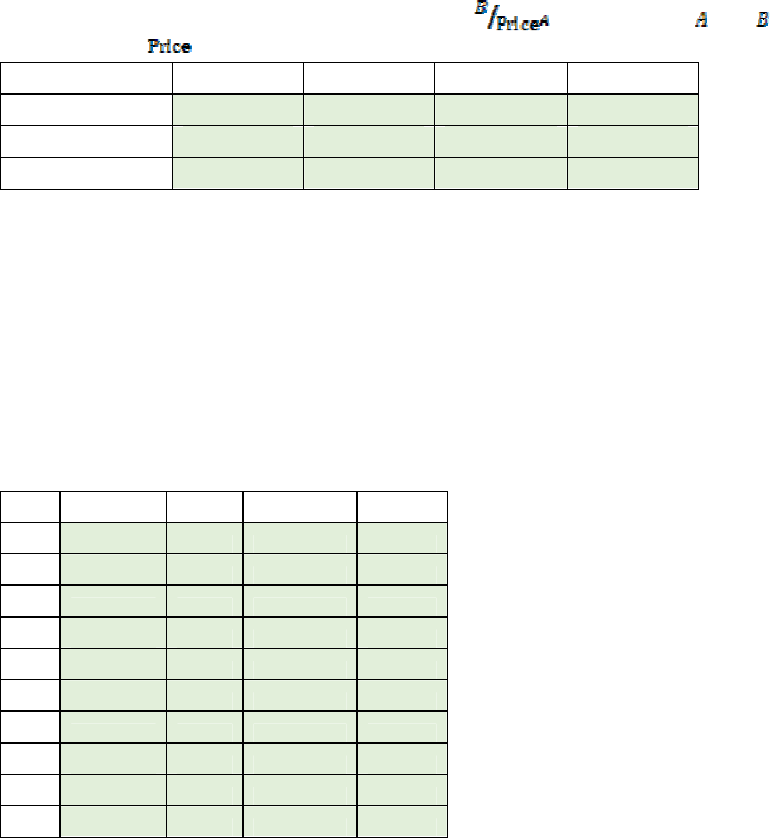
Proceedings of the EuSpRIG 2019 Conference “Spreadsheet Risk Management” ISBN : 978-1-905404-56-8
Copyright © 2019, EuSpRIG European Spreadsheet Risks Interest Group (www.eusprig.org) & the Author(s)
Page 9/12
Appendix A – Multidimensional Spreadsheet Challenge Kit
This section presents the material that was sent to the participants of the Multidimensional
Spreadsheet Challenge in November 2018. It consists of the problem statement, the Formula Diagram,
the Formula List and two screen captures showing the result for two different inputs.
Acme Techno Widgets Company
The Acme Techno Widgets Company (ATW) produces and sells widgets. Its salesforce is assigned to four
major sectors: Government, military, education and private. It produces two products, the Standard widget and
the Deluxe widget.
Market research has established that the annual demand for widgets depends on each sector’s Standard widget
price. The Pricing Director explains:
We start by setting a global base price. Then, for each sector, we tell our salesforce that they can offer a rebate.
For instance, we offer a 70% rebate to the education sector and it’s 10% for the private sector because
purchases are usually made by researchers with limited funds. The military sector gets a 20% rebate and the
government 40%. This is not made public: all our price lists show the base price, but our clients in each sector
are aware of the rebate they can get.
Each sector reacts differently to a change of price. We consulted with a market research expert and she came up
with multiple demand functions, one for each sector. The demand function estimates a sector’s annual demand
for a given base price. The demand function has the form . The parameters and are different for
each sector, and is the sector’s price, after the rebate. This table shows the values the expert gave us:
Sector Government Military Private Sector Education
Rebate Percentage 40% 20% 10% 70%
DemParA 3.59 3.46 3.18 4.11
DemParB 22000000000 22000000000 22000000000 22000000000
The price of the Deluxe widget is 45% higher than the Standard widget.
The Sales Manager explains the sales pattern:
The annual demand of each Sector is split between the Standard and Deluxe products, but the distribution is
very different in each sector. For instance, in the education sector, with its limited funds, the split is 80%-20%
and it is 25%-75% in the military sector. I guess these guys always go for the best, and they have higher
budgets. The distribution is 65%-35% for the government sector and 40%-60% for the private sector. The ratios
are then applied to the sector’s annual demand to get the annual demand by product.
Another interesting pattern is the distribution of sales during the year. We noticed that our clients buy more just
before the end of their fiscal year, when some want to spend their budget surpluses, and the beginning, when
others have new funds allotted. Each sector has a different pattern, and we noticed that it is pretty stable year
after year.
Government Military Private Sector Education
Jan 9% 8% 12% 6%
Feb 10% 9% 11% 8%
Mar 12% 10% 9% 9%
Apr 12% 12% 7% 10%
May 11% 13% 6% 12%
Jun 9% 11% 4% 12%
Jul 7% 9% 5% 11%
Aug 6% 7% 6% 9%
Sep 5% 6% 8% 7%
Oct 5% 4% 9% 6%
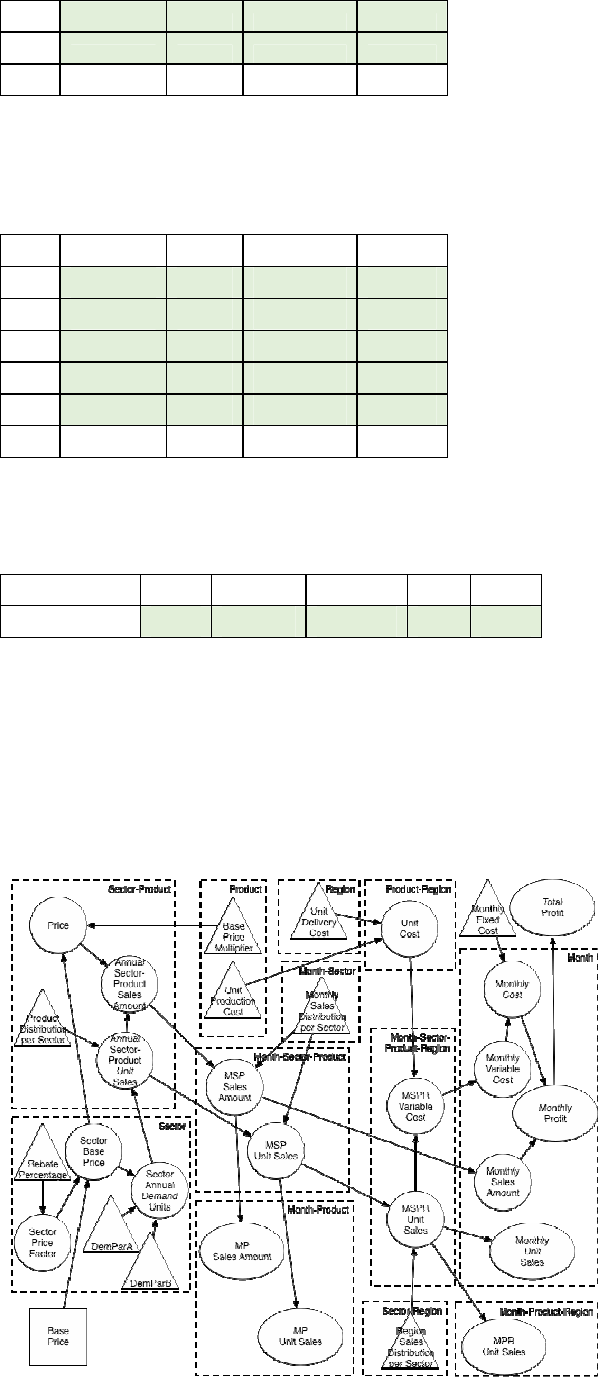
Proceedings of the EuSpRIG 2019 Conference “Spreadsheet Risk Management” ISBN : 978-1-905404-56-8
Copyright © 2019, EuSpRIG European Spreadsheet Risks Interest Group (www.eusprig.org) & the Author(s)
Page 10/12
Nov 6% 5% 11% 5%
Dec 8% 6% 12% 5%
Total 100% 100% 100% 100%
Sales to a sector are not uniformly distributed by region. For example, there are more universities in the South-
West than in the West. The following table shows the distribution of a sector’s sales by region. With it, we can
calculate the expected monthly sales per product per region, which helps our Logistics Department do its
planning.
Government Military Private Sector Education
N 25% 52% 22% 24%
SE 18% 13% 21% 15%
SW 18% 18% 17% 32%
E 22% 0% 25% 17%
W 17% 17% 15% 12%
Total 100% 100% 100% 100%
The costs of producing a widget are $48 and $72 for the Standard and the Deluxe widget respectively. The
monthly fixed costs for this year are $20000. Delivery costs depend solely on the region and are shown in this
table:
Region North South-East South-West East West
Unit Delivery Cost $10.25 $9.73 $9.58 $8.26 $11.02
The company CEO wants to see the following results:
• The monthly unit sales per product per region.
• The monthly sales amount and unit sales per product.
• The monthly unit sales and profit.
• The total profit.
Acme TechnoWidget Company Formula Diagram

Proceedings of the EuSpRIG 2019 Conference “Spreadsheet Risk Management” ISBN : 978-1-905404-56-8
Copyright © 2019, EuSpRIG European Spreadsheet Risks Interest Group (www.eusprig.org) & the Author(s)
Page 11/12
Acme TechnoWidget Company Formula List
Var
No
Variable Type Dimension Set Value / Formula
1 Base Price Input $100
2 Base Price Multiplier Data Product (1, 1.45)
3 Unit Production Cost Data Product list of values
4 Rebate Percentage Data Sector list of values
5 Sector Price Factor Calculated Sector 1-Rebate Percentage
6 Sector Base Price Calculated Sector Base Price * Sector Price Factor
7 DemParA Data Sector list of values
8 DemParB Data Sector list of values
9 Sector Annual Demand
Units
Calculated Sector DemParA*DemParB^-Sector Base Price
10 Unit Delivery Cost Data Region list of values
11 PR Unit Cost Calculated Product-Region Unit Production Cost + Unit Delivery Cost
12 Product Distribution
per Sector
Data Sector-Product list of values
13 Annual Sector-Product
Unit Sales
Calculated Sector-Product Sector Annual Demand Units * Product
Distribution per Sector
14 Price Calculated Sector-Product Sector Base Price * Base Price Multiplier
15 Annual Sector-Product
Sales Amount
Calculated Sector-Product Annual Sector-Product Unit Sales * Price
16 Region Sales
Distribution per Sector
Data Sector-Region list of values
17 Monthly Sales
Distribution per Sector
Data Month-Sector list of values
18 MSP Unit Sales Calculated Month-Sector-Product Annual Sector-Product Unit Sales * Monthly
Sales Distribution per Sector
19 MSP Sales Amount Calculated Month-Sector-Product Annual Sector-Product Sales Amount * Monthly
Sales Distribution per Sector
20 MSPR Unit Sales Calculated Month-Sector-Product-
Region
MSP Unit Sales * Region Sales Distribution per
Sector
21 MSPR Variable Cost Calculated Month-Sector-Product-
Region
MSPR Unit Sales * PR Unit Cost
22 Monthly Variable Cost Calculated Month SUM(MSPR Variable Cost)
23 Monthly Unit Sales Output Month SUM(MSPR Unit Sales)
24 Monthly Sales Amount Calculated Month SUM(MSP Sales Amount)
25 Monthly Fixed Cost Data $20000
26 Monthly Costs Calculated Month Monthly Fixed Cost + Monthly Variable Cost
27 Monthly Profit Calculated Month Monthly Sales Amount - Monthly Costs
28 MPR Unit Sales Output Month-Product-Region SUM(MSPR Unit Sales)
29 MP Unit Sales Output Month-Product SUM(MSP Unit Sales)
30 MP Sales Amount Output Month-Product SUM(MSP Sales Amount)
31 Total Profit Output SUM(Monthly Profit)
Proceedings of the EuSpRIG 2019 Conference “Spreadsheet Risk Management” ISBN : 978-1-905404-56-8
Copyright © 2019, EuSpRIG European Spreadsheet Risks Interest Group (www.eusprig.org) & the Author(s)
Page 12/12
References
Bregar, A. (2004). Complexity Metrics for Spreadsheet Models. Proc EuSpRIG.
EuSpRIG. (2019, 04 01). EuSpRIG discussion group. Retrieved from http://groups.yahoo.com/group/eusprig
FAST Standard Organisation. (2016, June). The FAST Standard. Retrieved 04 01, 2019, from http://www.fast-
standard.org/wp-content/uploads/2016/06/FAST-Standard-02b-June-2016.pdf
Hermans, F., Pinzger, M., & van Deursen, A. (2014). Detecting and Refactoring Code Smells in Spreadsheet Formulas.
Empirical Software Engineering (April).
LinkedIn. (2019, 04 01). Excel Developers. Retrieved from LinkedIn: https://www.linkedin.com/groups/58704/
Mireault, P. (2018). Structured Spreadsheet Modelling and Implementation with Multiple Dimensions - Part 2:
Implementation. Proc. EuSpRIG. London.
Raffensperger, J. F. (2003). New Guidelines for Spreadsheets. International Journal of Business and Economics, 2(2), 141-
154.
Reschenhofer, T., Waltl, B., & Matthes, F. (2016). A Conceptual Model for Measuring the Complexity of Spreadsheets.
London: Proc. EuSpRIG.
